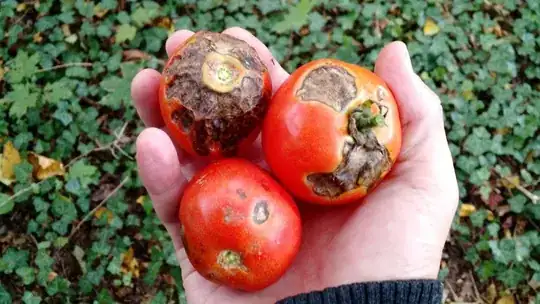EDIT: It looks a lot like anthracnose. I'm not really sure that it is, though.
I agree with Bamboo that it looks like the tomatoes were just damaged and started to go bad because of it. However, I don't think insects are the only cause. I think this can happen to cracked tomatoes, too, and perhaps sometimes when they're smothered by tomato branches. I'm guessing nutritional deficiencies that result in weaker tomatoes might contribute to this.
I think this is exactly what old grocery store tomatoes in the refrigerator look like when they go bad. (I know, people say not to refrigerate tomatoes, since they lose taste; but they do last longer when cold.)
I've seen damage like this on my tomatoes in previous years, and it was only an occasional thing. It didn't overrun the plants or anything. I don't live in a humid area, though. My tomatoes this year had plenty of basalt rockdust (which is high in silica, calcium and trace minerals), potassium and such. They seemed to be a lot stronger, and I don't recall seeing this issue at all, this time. There was a similar issue with cantaloupe quality last year (they looked rather grungy, had indents, and they went bad fast; they remind me of your tomatoes, there, somewhat), and this year the cantaloupe are awesome, and perfect-looking. They're actually growing on the same ground, too. Same soil.
A proper balance of potassium, calcium and silica can strengthen plants quite a bit, including against insects and disease. If your soil had too much nitrogen, it may have inhibited your potassium. I have a suspicion that too much nitrogen may interfere with calcium uptake, too.
So, my conclusion is that the underlying problem is nutritional—but the initial damage is probably caused by mechanical means, which in turn just causes the tomatoes to go bad.
A soil test might be insightful.
Basalt rockdust works best if applied far in advance, I've read. I didn't apply it far in advance. I recommend doing it far in advance, though (or putting it in your compost).
I added worm castings with the basalt rockdust so that the microbes on the worm castings would hopefully combine well with the rockdust. Microbes are supposed to like rockdust. They're also supposed to be great for plants.
